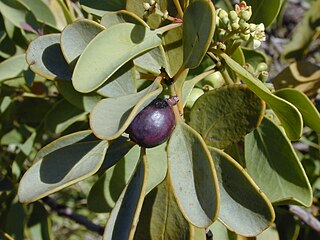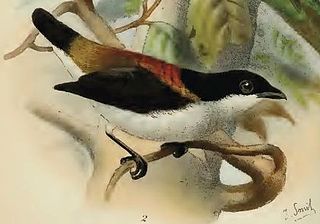
Abacá, binomial name Musa textilis, is a species of banana native to the Philippines, grown as a commercial crop in the Philippines, Ecuador, and Costa Rica. The plant, also known as Manila hemp, has great economic importance, being harvested for its fiber, also called Manila hemp, extracted from the leaf-stems. Abacá is also the traditional source of lustrous fiber hand-loomed into various indigenous textiles in the Philippines like t'nalak, as well as colonial-era sheer luxury fabrics known as nipís. They are also the source of fibers for sinamáy, a loosely woven stiff material used for textiles as well as in traditional Philippine millinery.

The Santalaceae, sandalwoods, are a widely distributed family of flowering plants which, like other members of Santalales, are partially parasitic on other plants. Its flowers are bisexual or, by abortion, unisexual. Modern treatments of the Santalaceae include the family Viscaceae (mistletoes), previously considered distinct.

Nepenthes mindanaoensis is a tropical pitcher plant native to the Philippine islands of Mindanao and Dinagat.
Martin Roy Cheek is a botanist and taxonomist at the Royal Botanic Gardens, Kew.
The Cebu tamaraw is a fossil dwarf buffalo discovered in the Philippines, and first described in 2006.

The Cebu flowerpecker is a small passerine bird. It is endemic to Cebu Island in the Philippines. Feared to have become extinct early in the 20th century, it was rediscovered in 1992 in a small patch of limestone forest in the Central Cebu Protected Landscape. It has since been found at three other sites, namely the Nug-as forest of Alcoy, Mount Lantoy of Argao and the forests of Dalaguete. This four-colored bird normally grows to 11 or 12 centimeters. The male is characterized by a large, triangular, scarlet to vermilion coat stain. In the female, the top is brown. The Cebu flowerpecker consumes small fruits and mistletoe plants and is generally active in the mornings to avoid competition with more aggressive birds. Despite attempts to protect its habitat it remains critically endangered due to illegal logging.
The lemon-throated leaf warbler is a species of Old World warbler in the family Phylloscopidae.

The Black shama is a species of bird in the family Muscicapidae. It is endemic to the island of Cebu, Philippines where it is known locally as "Siloy".

Alastair S. Robinson is a taxonomist and field botanist specialising in the carnivorous plant genus Nepenthes, for which he is regarded as a world authority. He is currently Manager Biodiversity Services at the National Herbarium of Victoria, Royal Botanic Gardens Melbourne, where he oversees identification botany services, the Library and Artwork components of the State Botanical Collection, and the botanical journal Muelleria, a peer-reviewed scientific journal on botany published by the Royal Botanic Gardens Victoria, for which he is Editor in Chief.

Decaisnina is a genus of semi-parasitic shrubs (mistletoes) that occur in Australia. The type species is D. glauca. Around thirty species are known, found from northern Australia to Tahiti and the Philippines.
Sicyopus cebuensis is a species of fish that was first documented by Chen and Shao in 1998, who documented just a single adult pair located in the Uling brook within the upper Naga River basin on the island of Cebu, Cebu province, the Philippines.
Conus cebuensis is a species of sea snail, a marine gastropod mollusk in the family Conidae, the cone snails, cone shells or cones.

Amylotheca is a genus of hemi-parasitic aerial shrubs in the family Loranthaceae, found in Borneo, Malaysia, New Caledonia, New Guinea, Australia, Sumatra, Thailand, Vanuatu, and Philippines

Daniel Lee Nickrent is an American botanist, working in plant evolutionary biology, including the subdisciplines of genomics, phylogenetics, systematics, population genetics, and taxonomy. A major focus has been parasitic flowering plants, particularly of the sandalwood order (Santalales). His interest in photographic documentation and photographic databases has led to several photographic databases including Parasitic Plant Connection, Phytoimages, Plant Checklist for the Rocky Mountain National Park, and Plant Checklist for the Crab Orchard National Wildlife Refuge.
Amyema lisae, is a species of flowering plant, an epiphytic hemiparasitic plant of the family Loranthaceae first discovered in 2017 at Balinsasayao - Twin Lakes Natural Park, in the island of Negros, Philippines. Amyema lisae differs due with verticillate arrangements of leaves and simple umbels in the inflorescences. Its leaves are also relatively smaller leaves. The 5-merous flowers are tomentose and yellow, making it the only mistletoe species in the Philippines to have a yellow flower.
Amyema nickrentii is an epiphytic, flowering, hemiparasitic plant of the family Loranthaceae native to the Philippines. It was found in coastal forest in the Aurora Province and "differs from all other described Amyema species in having a whorled leaf arrangement with mostly nine flat linear leaves per node".
The Philippine Taxonomic Initiative (PTI) is a private Philippine research institute and non-profit organization founded in 2018, located in the Philippines.
Lepeostegeres is a genus of flowering plants belonging to the family Loranthaceae.








